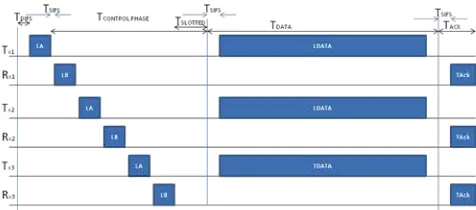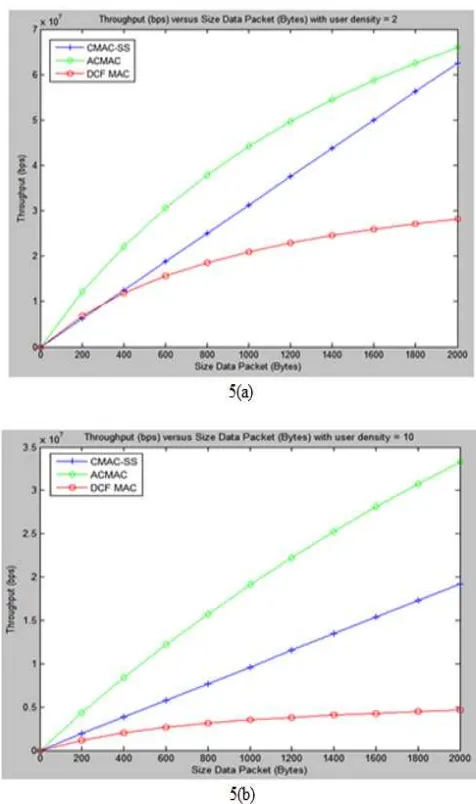Abstract— This paper proposes an adaptive concurrent
transmission protocol implemented in Wireless Mesh Network (WMN), which reduces the overhead due to signaling of the existing concurrent transmission protocols such as Medium Access Control (MAC) protocol with Acknowledgment and Parallel mechanism (MACA-P), Concurrent MAC with Short Signaling (CMAC-SS) and Distribution Coordination Function (DCF). DFC protocol is widely used and implemented in the existing IEEE 802.11b/g/n standard wireless networks. The use of DCF in WMN reduces the throughput per hop significantly due to exposed node avoidance mechanism such as Ready-to-Send and Clear-to-Send (RTS-CTS) signaling which allows only one transaction per node at one time; meaning that the waiting delay is higher in Wireless Mesh Network (WMN). MACA-P and CMAC-SS protocols introduce concurrent transmission mechanism that allows multiple transactions per hop at one time. The results from the simulation show that the performance of CMAC-SS is better than the MACA-P. However the design of both MACA-P and CMAC-SS considers fixed size of signaling which makes the protocol not scalable when the number of user within the network increases. In order to provide scalability, an adaptive size of signaling is introduced in this paper by manipulating the broadcast nature of the wireless network within the slotted framework. Such adaptive mechanism improves scalability and also the throughput per hop by 45% compared to CMAC-SS when the number of nodes is higher than 10.
Index Terms— Adaptive Concurrent Transmission;
Wireless Mesh Network; Throughput.
I. INTRODUCTION
A
daptive Concurrent MAC or ACMAC protocol has been proposed to tackle the problem of concurrent transmission in WMN. The use of IEEE 802.11 DCF MAC is not practical in WMN because it does not allow concurrent transmission to take place [1]. When RTS-CTS is performed, exposed nodes problem happens which increase the network delay due to waiting time. The throughput drops significantly as the number of hops and user density grows. Medium Access Control with Collision Avoidance and Parallel transmission or MACA-P protocol is one of the solutions that had been proposed to enable concurrent transmission in multi-hop network [2]. MACA-P introduces additional control packets to coordinate concurrent transmission with the first node initiates transmission considered to be the master of the network. Other nodes that have data packets to be sent will have to follow the timing of the master. However the number of nodes that can involves in the concurrent transmission is fixed and depends on the length of the allowed control part. Therefore if the number of nodes requires concurrent transmission is greater than the number of nodes allowed for concurrent transmission by the control phase, the remaining nodes are eventually in exposed state. This problem leads to scalability issue in the implementation of MACA-P in WMN.In order to solve the scalability problem, in this paper we introduce a new approach where the size of the control phase can be changed adaptively depending on the number of nodes requesting for concurrent transmission. By this approach, we demonstrate that the scalability problem can be solved while increasing the network throughput.
Section I introduces the problem of exposed node in WMN and various concurrent transmission technique to combat the problem. The network model and the proposed ACMAC protocol operation are explained in details in Section II and the performance of the proposed protocol are evaluated and analyzed in Section III. Finally the paper is concluded in Section IV.
Adaptive Concurrent Transmission Protocol for
Wireless Mesh Network
M. S. Ibrahim , M. R. Ahmad, and
V. R. Gannapathy
Faculty Electronic and Computer Engineering, Universiti Teknikal Malaysia Melaka (UTeM)
Hang Tuah Jaya, 76109 Durian Tunggal Melaka, Malaysia,
II. NETWORK MODEL
The basic components of the network model for WMN is basically consisting of mesh routers, mesh clients, and gateway(s) to the Internet as shown in Figure 1. There are M
mesh routers and N mesh clients. The number of mesh
router is fixed at three denoted as routers X, Y, and Z.
Meanwhile the number of active mesh clients allowed per concurrent transmission is three (denoted as A, B, and C)
due to the constraint introduced by the number of mesh routers. The total number of active mesh nodes is given as n.
The system operates at 2.4 GHz with single channel configuration for both mesh client and router communications. Consider the network model working on line of sight area, the radius of the mesh router coverage is r
(in meter) and radius of the mesh client is d (in meter).
The routers are connected to each other in mesh fashion and mesh clients connected to one of the mesh routers in star topology manner. The uplink communication from the mesh client to the mesh router is the focus of this paper with transmission is initiated by the mesh clients.
III. PROTOCOL DESCRIPTION
The proposed ACMAC protocol is to enable the concurrent transmission while reducing the exposed node problem. The number of concurrent transmissions is depending on the number of active node n and the size of the time slot. The
size of one time slot is fixed at 20us [9].
When a node has data packet ready to be sent, the transmission begins by the source node transmitting advertisement packet (AP) to its mesh router inside the source node coverage, d. Once a mesh router receives AP,
it will generate a broadcast packet (BP) and immediately broadcasts the BP packet to all nodes inside its coverage r.
If a mesh router has data packet to be sent, it will transmit BP packet immediately to all nodes inside its coverage area,
r.
After the reception of the BP packet, if a node is a mesh client, the node updates their neighbors list and after that discards the broadcast packet. If a node is a mesh router, the packet will be broadcasted immediately to all nodes inside its coverage.
To enable the concurrent transmission, any active mesh clients will observe the duration field of BP packet in order to align their data packet transmission with the source node. All the active nodes including the source node will wait for two time slots period (40us), and if there is no reception of BP packet, the concurrent transmission begins. By introducing this waiting period after neighbors list update, the length of the control phase can be adjusted dynamically based on the number of active nodes involved in concurrent transmission. The concurrent transmission is shown in Figure 2 in the form of timing diagram.
Figure 1: Network Model with Tree Actice Nodes.
Figure 2: Timing Diagram of Adaptive Concurrent MAC
Figure 3: Advertisement and Broadcast Packet Format IV. PERFORMANCE ANALYSIS
The performance of the network is depending on the number of active user, the data packet size and overhead introduced by the control phase. The delay is defined as the time consumes for data packet travels from the source node (mesh client) to destination node (mesh router). The mathematical modeling below must be considered for all the protocols to be compared with ACMAC and the then results are evaluated and analyzed.
Figure 5(a) shows the performance of all three protocols when concurrent transmission is allowed with the number of active nodes is 2. The ACMAC protocol improves the throughput by 4.5% compared to CMAC-SS and by 56% compared to DCF. Furthermore when the number of active nodes is increased to 10, ACMAC outperforms both CMAC-SS and DCF protocols by improving the throughput to 45.45% and 85% respectively as shown in Figure 5(b).
V. CONCLUSION
This paper presents an improved concurrent MAC protocol or known as ACMAC which has improved the throughput of the existing concurrent MAC protocols for wireless mesh network. The analysis shows that the ACMAC outperforms both CMAC-SS and DCF protocols over than 45% in throughput improvement.
VI. REFERENCES
[1] E. Ziouva and T. Antonakopoulos, “Small-Scale Ad-Hoc Wireless LANs”
[2] A. Acharya1, A. Misra1, S. Bansal, “MACA-P : A MAC for Concurrent Transmissions in Multi-hopWireless”
[3] V. R. Gannapathy, M .R .Ahmad, M .K . Saudi, M. S. Johal, “Concurrent MAC with Short Signaling for Multi-hop Wireless Mesh Networks”, ICUMT2009, St-Petersburg, Russia, OCT2009K. [4] D. Shukla, L. Chandran and S. Iyer: “Mitigating the Exposed Node
Problem in IEEE 802.11 Ad Hoc Networks”.
[5] M. M Rana, K. E. U. Ahmed, R. Karim, H. M. Tareque, M. I. Hasan :”An Adaptive and Efficient MAC Protocol for Wireless Mesh Networks: An Extension of MACA-P M”.
[6] I. F. Akyildiz: “A Survey on Wireless Mesh NetworkArticle in a journal”
[7] S. C. A. Thomopoulos :“Simple and Versatile Decentralized Control for Slotted ALOHA, Reservation ALOHA, and Local Area Networks”
[8] M. Oliver, A. Escudero: “Study of different CSMA/CA IEEE 802.11-based implementations”
[9] S. C. Wang, Y . M. Chen, T. H. Lee, A. Helmy. ”Performance Evaluations for Hybrid IEEE 802.1lb and 802.1lg Wireless Network.
Figure 4: Throughput vs. Packet Size when n = 1.
Figure 5(a): Throughput vs. Packet Size when n = 2.

